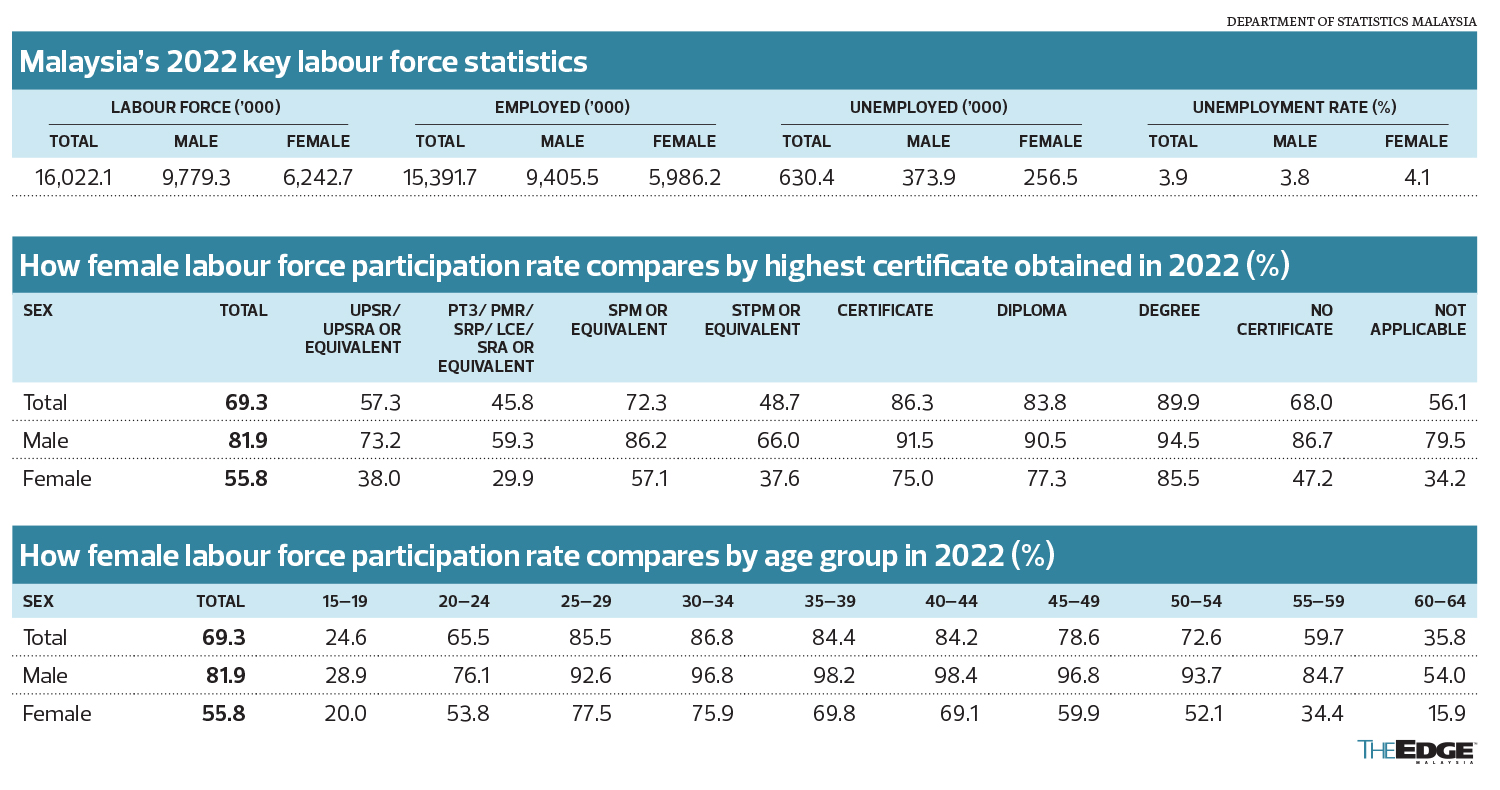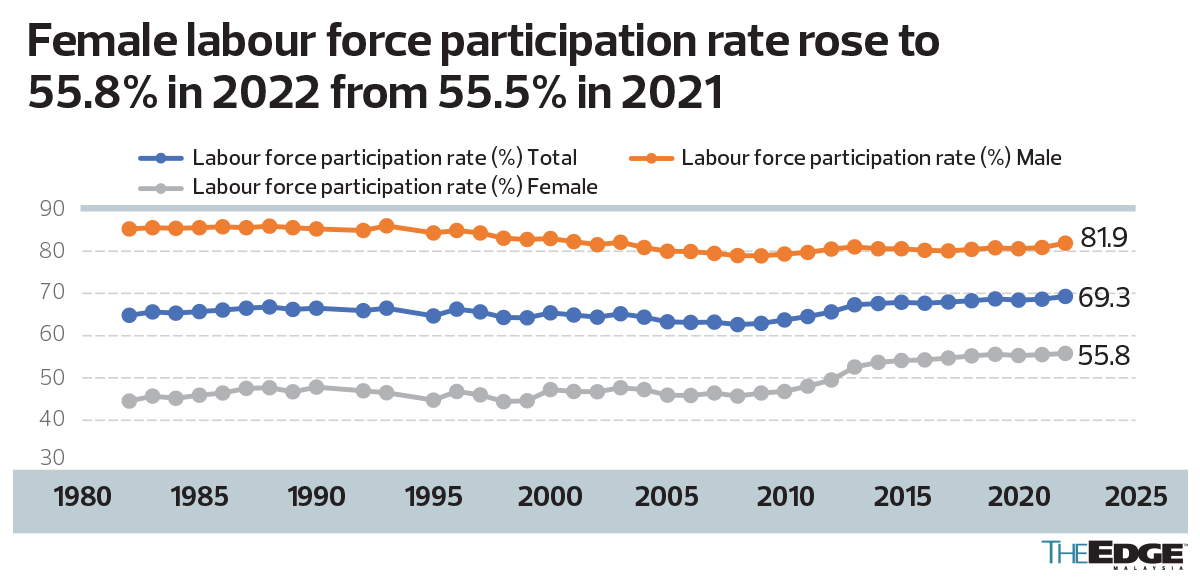
This article first appeared in The Edge Malaysia Weekly on August 7, 2023 - August 13, 2023
WITH the low female labour force participation rate named among the nine challenges Malaysia faces in the country’s bid to sustainably rejuvenate economic growth, the need to raise the rate to 60% within 10 years or earlier is one of seven economic mission-targets announced by Prime Minister Datuk Seri Anwar Ibrahim in his recent “Madani Economy” speech.
Apart from gaining more equitable outcomes for women — who, to borrow from an old Chinese saying, “hold up half the sky” — there is a clear economic motivation.
“The promotion of economic opportunities for women is one of the most promising avenues for fulfilling the country’s development potential,” write researchers at the World Bank Group Global Knowledge and Research Hub in a report titled “Breaking Barriers: Towards Better Economic Opportunities for Women in Malaysia” released in September 2019.
Among other things, the report notes that Malaysian girls perform better than boys in school, making up 55% of graduates in institutions of higher learning. Girls also account for 67% of students studying science and mathematics, 40% of ICT-related subjects and 34% of engineering subjects. According to the report, Malaysia’s per-capita income could grow 23.7% to RM44,182 in the short run and 26.2% to RM45,075 in the longer run — which implies an annual per-capita income gain of RM9,400 for every Malaysian (given that Malaysia’s per-capita income had averaged RM35,717 in the 2010-to-2017 period used as its baseline model) — if all economic barriers were removed to afford a greater proportion of women opportunities to fill higher-paying jobs.
For that to happen, more women need to first be in the labour force.
According to data from the Department of Statistics Malaysia (DoSM), female participation in the labour force has been on a slow but steady increase — rising every year in the past 14 years, except for 2020 — climbing from 46.4% in 2009 to 55.6% in 2019 before sliding to 55.3% in 2020. In 2021, however, the female labour participation rate rose again to 55.5% and further increased to 55.8% in 2022, according to latest DoSM data.
Behind Vietnam, Singapore, China
Four years ago, the World Bank had noted that the proportion of women participating in the labour force in Malaysia at 55.2% in 2018 “remains low” compared with other Asean peers. Numbers have inched higher since, but there remains much catching-up to do, with Malaysia’s target of 60% within 10 years behind the current rate in Vietnam, Singapore as well as China.
In 2022, Vietnam had the highest women participation rate in the labour force at 69.1%, topping even Singapore’s 63.2% and Thailand’s 58.7%, according to World Bank data. Malaysia’s 55.8% is ahead, however, of Brunei’s 55.5%, Laos’ 55.4%, Indonesia’s 52.7% and the Philippines’ 46%. It is also ahead of South Korea’s 54.6% and Japan’s 54%, but behind China’s 61.1%.
Back then, researchers at the World Bank had calculated that Malaysia should have about 500,000 more women who are not working but ought to be working, when benchmarking Malaysia’s per-capita income in 2018 against all countries. (That the figure is much higher than the 256,500 unemployed women in the labour force reflects the many women who are not actively seeking employment, thus resulting in low women labour force participation rate versus the rate for men.]
When benchmarking against Singapore, the researchers say Malaysia should have 1.5 million more women working. Malaysia should have more than two million more women working, if its female labour participation rate were benchmarked against Canada, “which is among the high-income countries with the highest female labour participation rate (at 75.1% in 2018 versus Malaysia’s 55.2%)”.
There is a clear gap with men, whose labour force participation rate was 81.9% in 2022, up from 80.9% in 2021 and 80.4% in 2018, DoSM data shows. Using 2018 data, the researchers had noted that Malaysia’s gender gap in labour participation rate of 25.2 percentage points is “markedly higher than the gaps in Singapore (14.1 percentage points) and Thailand (15.2 percentage points)”. According to them, closing the gender gap in labour force participation could boost Malaysia’s per-capita income by 18.4% in the long run — they note that every percentage point increase in the female labour participation rate would increase per-capita income by 0.5% in the short run and 0.56% in the long run.
Tapping the ‘younger older women’
A problem, if you will, that researchers have long pointed out is that Malaysia needs to get more of its older women to work.
“One of the most striking findings of the Malaysia Economic Monitor on ‘Unlocking Women’s Potential’ (World Bank, 2012) was that Malaysia’s age-participation profile in 2010 was single-peaked, meaning that participation was lower for middle-aged women than for young adults and lower still for older women. This contrasted with the age-participation profiles of countries like Japan and Korea, where there is an initial peak when young women enter the labour force, a decline as they marry and have children, and then a second peak as they re-enter the labour force,” researchers write in the World Bank report. “With Malaysia’s workforce rapidly ageing, tapping the economic participation of such ‘younger older’ women will become increasingly important.”
The female labour force participation rate remains higher among young adults than middle-aged and older women today.
According to DoSM data for 2022, the labour participation rate is highest among women aged 25 to 29 at 77.5% (74.2% in 2018), followed by 75.9% for women aged 30 to 34 (72.8% in 2018).
The participation rate among women aged 35 to 39 and 40 to 44 improved to 69.8% and 69.1% respectively in 2022 (68.9% and 66.7% respectively in 2018).
The labour participation rate among women aged 45 to 49 declined, however, to 59.9% in 2022 compared with 63.4% in 2018. Women aged 50 to 54 participating in the labour force also fell to 52.1% in 2022 compared with 53.8% in 2018.
And even though the retirement age was raised from 55 to 60 in 2013, only 34.4% of women aged 55 to 59 were still in the labour force in 2022, down from 40.6% in 2018. Only 15.9% of women aged 60 to 64 were still active participants in the labour force in 2022, down from 22.7% in 2018, DoSM data shows.
According to DoSM, the labour force participation rate is also lower among less educated women.
Even among the more educated, only 66.2% of women with tertiary education participate in the labour force, much lower than the 82.6% for men, dragging the average lower to 74.1%. Similarly, only 85.5% of women with at least a degree are in the labour force in 2022 compared with 94.5% for men.
Apart from improving education and skills training, policymakers are well aware that access to affordable child and elderly care services are essential for more women to remain in or return to the workforce and be in more productive jobs that match their education level.
Seasoned economists would know that Malaysia had wanted to lift the female labour participation rate to 59% by 2020 under the 11th Malaysia Plan. It is more important today than before that Malaysia succeeds in this mission.
Save by subscribing to us for your print and/or digital copy.
P/S: The Edge is also available on Apple's App Store and Android's Google Play.
- SumiSaujana slumps on ACE Market, on course to be worst IPO debut
- US bonds, dollar battered as 'sell America' trade heats up
- Malaysian palm oil producers could capture US market share from Indonesia with better pricing — CGS International
- Lawyer launches constitutional challenge against Judicial Appointments Commission's judge appointment power
- Malaysian stocks broadly lower as Trump’s reciprocal tariffs come into force
- SK Hynix tops Samsung Elec in DRAM market share for first time, researcher says
- PSP Energy seeks ACE Market IPO to expand ship-to-ship bunkering biz
- Asian buyers shun US farm goods, hit by ship crunch and trade war
- TALKING EDGE: SumiSaujana talks about not sticking to formula
- Malaysia among countries that could boost market share as US tariffs shift Apac trade — Moody’s



